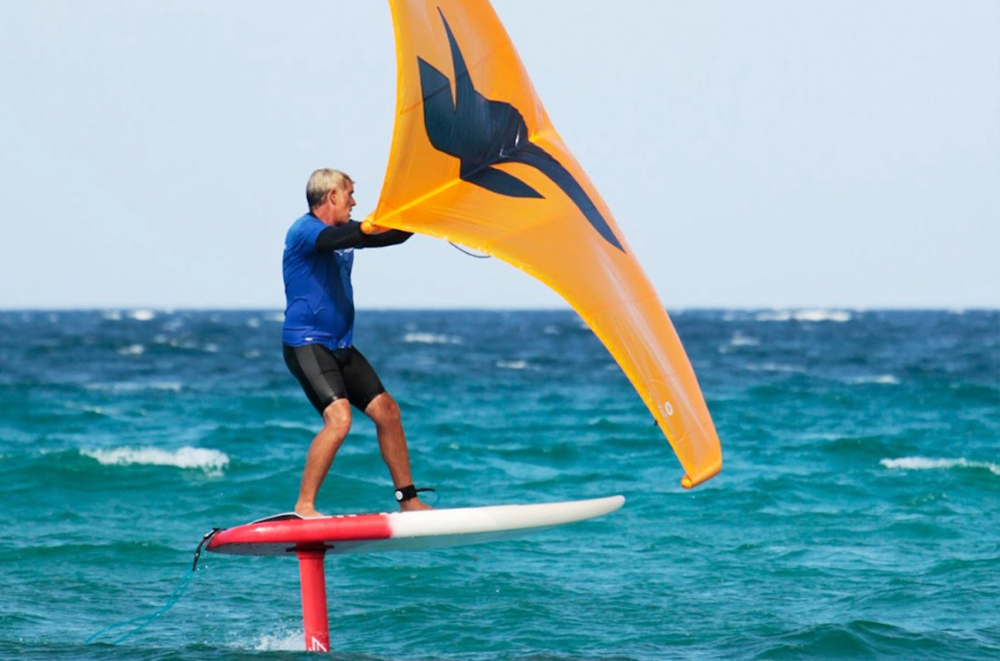Wingfoiling in Mallorca is set to become a cornerstone of modern water sports. It is an exhilarating water sport that combines elements of surfing and wind sports, but it stands distinct from windsurfing and kiteboarding. This sport involves using a handheld wing to harness the wind while riding a board equipped with a hydrofoil. If you’re new to wingfoiling, this guide will help you understand the essential equipment, the basics of getting started, and the types of foils used.
What is Wingfoiling?
Wingfoiling, also known as wingsurfing, is a cutting-edge water sport that seamlessly merges the dynamics of windsurfing, kiteboarding, and foiling. This innovative sport involves the use of a handheld inflatable wing to harness the wind’s power, propelling the rider forward on a specialized board equipped with a hydrofoil. The hydrofoil, a lifting surface mounted beneath the board, allows the rider to elevate above the water’s surface, reducing drag and creating a smooth, efficient, and exhilarating ride.
Essential Equipment for Wingfoiling
To get started with wingfoiling, you’ll need three main pieces of equipment: the wing, the board, and the hydrofoil. Let’s delve into each component:
Wings:
The wing is a handheld, inflatable sail designed to capture the wind and propel the rider. Unlike traditional sails used in windsurfing, the wing is not attached to the board, allowing for greater freedom of movement.
Wings vary in size, typically from 2 to 7 square meters. The appropriate size depends on your weight, skill level, and wind conditions. Larger wings are better for lighter winds, while smaller wings are ideal for stronger winds.
Wings are made from durable, lightweight materials like ripstop nylon and feature inflatable struts to maintain their shape.
Foilboards:
A foilboard is a specialized board designed for use with a hydrofoil. These boards are generally shorter and wider with more compact aerodynamique shape that’s allow you to have fast and easy take off than traditional surfboards or windsurf boards.
Specific foilboards for wingfoiling often come with foot straps or a deck pad for better grip and control.
Hydrofoil:
The hydrofoil is a lifting surface mounted beneath the foilboard. It consists of a mast, fuselage, front wing, and rear stabilizer.
As the rider gains speed, the hydrofoil generates lift, raising the board above the water and reducing drag. This allows for a smoother and more efficient ride.
There are different types of hydrofoils, categorized by their aspect ratios: low aspect, mid aspect, and high aspect foils.

Types of Hydrofoils
Understanding the different types of hydrofoils is crucial for selecting the right equipment based on your skill level and riding style.
Low Aspect Foils:
Characteristics: Wider and shorter wings with a lower aspect ratio.
Advantages: Provide more lift at lower speeds, making them ideal for beginners and those learning to foil. They are more stable and easier to control.
Usage: Best for learning, light wind conditions, and more relaxed riding.
Mid Aspect Foils:
Characteristics: A balance between low and high aspect ratios, offering a mix of width and length.
Advantages: Offer a good balance of lift, speed, and maneuverability. They are versatile and suitable for a variety of conditions.
Usage: Ideal for intermediate riders looking for a blend of performance and ease of use.
High Aspect Foils:
Characteristics: Longer and narrower wings with a higher aspect ratio.
Advantages: Provide higher speeds and better efficiency. They require more skill to control but offer advanced riders the ability to perform more dynamic maneuvers.
Usage: Best for experienced riders and high-speed riding in stronger winds.
Getting Started with Wingfoiling in Playa de Muro, Mallorca
Wingfoiling in Mallorca is set to become a cornerstone of modern water sports. Our Bay of Alcudia in Playa de Muro is for sure one of the best places to start. Perfect wind conditions and outstanding scenery.
Having said that, we are happy to introduce to you the first steps in the following chapter.
Now that you’re familiar with the essential equipment and types of hydrofoils, here are some steps to get started with wingfoiling.
Learning the Basics:
Begin by practicing with the wing on land. Get comfortable handling it, understanding how to control the wind’s force.
Move to a calm body of water. Start by kneeling on your foilboard and using the wing to propel yourself. This helps you get accustomed to balancing and steering.
Mastering the Foil:
As you progress, try standing up on the foilboard. Start in light winds and focus on maintaining balance while controlling the wing.
Experiment with the hydrofoil. Practice gaining speed and feeling the lift generated by the foil. This process takes time and patience.
Safety Tips:
Always wear a leash attached to your board to prevent it from drifting away if you fall.
Use a personal flotation device (PFD) or impact vest, helmt for added safety.
Check weather conditions and avoid wingfoiling in extreme winds or rough waters, especially as a beginner.

Wingsurfing Courses with Watersports Mallorca in Playa de Muro
The professional guidance from our wingfoiling instructors will ensure you develop good habits from the start!
Wingsurfing Beginner Course Outline
Introduction to Wingsurfing – Crash or Intensive Course
- Overview of the sport
- Understanding equipment: wing, board, foil, safety gear
Safety Briefing
- Importance of safety equipment
- Understanding weather conditions and their impact
Equipment Setup
- How to inflate and set up the wing
- (Attaching the foil to the board) – depending on the course
- Proper maintenance and storage
Basic Handling of the Wing
- Wing handling on land
- Wind window theory
- Basic wing control techniques
Getting on the Water
- Body positioning on the board
- Kneeling and standing up on the board
- Using the wing to generate power and propel the board
Basic Maneuvers
- Steering and controlling speed
- Tack and jibe techniques (turning the board)
Introduction to Foiling
- Understanding how the foil works
- First attempts at foiling (with instructor assistance)
- Balancing on the foil
Structure: One-on-one or small group sessions to ensure personalized attention and safety.
Wingfoiling Private Lessons in Playa de Muro, Mallorca
What you can learn in our wingfoil lessons
Introduction to Equipment:
- Wing: Understanding the structure and handling of the inflatable wing.
- Board: Getting familiar with the different types of boards, especially those with hydrofoils.
- Foil: Learning about the hydrofoil and its components.
Safety Basics:
- Wind and Weather Conditions: Recognizing safe conditions to wingfoil.
- Personal Safety Gear: Importance of wearing a helmet, impact vest, and leash.
- Self-Rescue Techniques: What to do if you find yourself in trouble on the water.
Handling the Wing:
- Inflating and Rigging: Properly inflating the wing and setting it up for use.
- Basic Wing Control: Learning to hold, steer, and handle the wing on land before getting into the water.
Starting on the Water:
- Getting on the Board: Techniques for mounting the board while holding the wing.
- Kneeling and Standing Up: Practicing balance and transitioning from kneeling to standing.
- Basic Stance and Positioning: Finding your center of gravity and maintaining stability.
First Flights:
- Powering Up the Wing: Using the wind to gain speed and control.
- Foiling Basics: Learning how to lift the board onto the foil and maintain flight.
- Turning and Maneuvering: Basic turns, tacks, and jibes to change direction.
Progressing Your Skills:
- Speed Control: Managing your speed and staying in control.
- Advanced Maneuvers: Introduction to more advanced techniques as you gain confidence and experience.
In our courses we are using Flysurfer Moja Surf Wing and Ozone Wings.
By following a structured course and practicing consistently, you’ll be able to progress from beginner to confident wingfoiler.
Enjoy the journey and have fun on the water!
Join our Watersports Community and book your wingsurf or wingfoil lesson with us!





